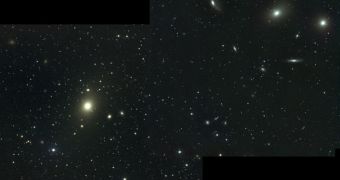Skywatchers and amateur astronomers in the Northern Hemisphere will soon be able to see components of the Coma/Virgo supercluster, one of the largest structures in the observable Universe. The objects will start to become visible throughout this spring.
Also called the “Realm of Galaxies,” the supercluster is made up of a large number of galactic groups, one of which is the Local Group. This structure contains the Milky Way, the Andromeda Galaxy, the Large and Small Magellanic Clouds, and several others.
There are several such groups inside the massive supercluster, which astronomers say it's among the largest in space. Our relative position inside this stellar arrangement will enable Northern Hemisphere to start observing most of Coma/Virgo starting this month,
To get an idea of just how large this structure is, consider that our planet, the Sun, and the entire solar system make up only a small dot in one of Milky Way's spiral arm. The galaxy itself is about 100,000 light-years in diameter.
It also contains between 100 and 400 billion stars, and it's not even the largest in the Local Group. Andromeda is a bit larger than our galaxy, and it too is smaller than some of the behemoths in the other groups making the supercluster.
As such, for those interested in observing a wealth of galaxies, Coma/Virgo provides an ideal opportunity. The cosmic arrangement features billions and trillions of stars, and hundreds of galaxies of all shapes and sizes.
However, some preparations need to be made before an observation session is attempted. Large binoculars or medium telescopes are needed in this endeavor, as even the brightest galaxies in this group appear only as faint patches of light on the night sky.
According to experts, amateur equipment can only reveal about 20 of the elliptical and spiral galaxies in the cluster, whereas more than 2,000 have thus far been detected with professional equipment.
Studying the Coma/Virgo supercluster is tremendously important, because this is where the Milky Way is going. In about 5 billion years – at the same time the Sun will run out of fuel – our galaxy will collide and merge with Andromeda.
The newly-formed object, which will most likely be a supermassive galaxy, will then continue onwards towards the center of the supercluster, like all other galaxies in our cosmic vicinity.
This trend is repeated throughout the Universe, where smaller galaxies are attracted towards the hearts of the nearest superclusters. It would appear that the Cosmos will look very different in several billions of years, when these structures finish assembling themselves, Universe Today reports.

 14 DAY TRIAL //
14 DAY TRIAL //